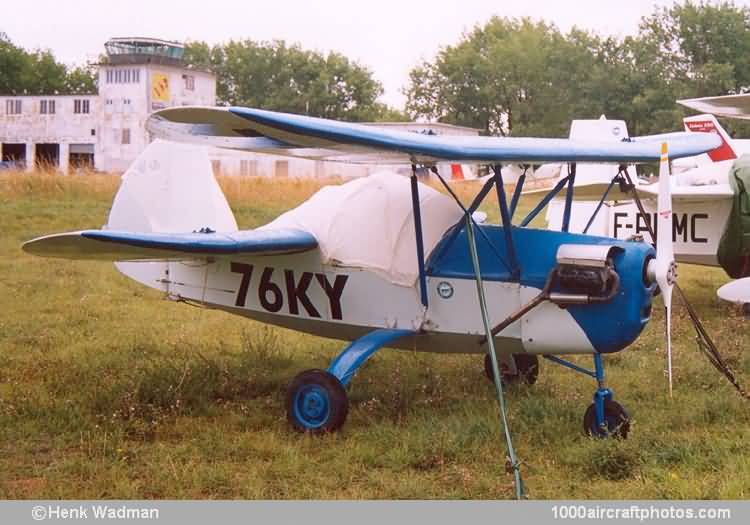12/31/2013. Remarks by Walter van Tilborg: "The first post-war Pou-du-ciel (Flying Flea) design of Henri Mignet and also the most-widely built of all his designs was the HM.290 and its many variants. The design had been inspired by the 1945 HM.280 Pou-Maquis (built for the military) and was mainly intended to make it suitable for amateur construction. It retained the same wood and fabric construction and had foldable wings. Usually homebuilt examples were built with a tail wheel landing gear, but also aircraft with a tricycle gear appeared.
The type was built in many countries around the world, often modified and with many different engine types, here an extensive listing:
HM.290: The prototype built in France by Mignet and first flown during 1948. It had one 28-30 hp Poinsard two-cylinder engine and 18 ft (5.49 m) wingspan. Later the HM.290 plans became (and still are available via Falconar Avia, Inc in Canada) for engines in the 30-70 hp range.
HM.290D: Slightly improved HM.290 variant, at least one was built in France with a modified VW engine.
HM.290E: Version with slightly increased span and length and a 25-31 hp Hirth F263 two-stroke engine. This version is also still marketed via Falconar.
HM.290GD: Sole example constructed in 1966 by Maurice Gagnant and Mr. Delpech, registered as F-PTXX. Power plant was a VW-engine.
HM.291: Designation for a single modified HM.290 flown in July 1946 and re-designated as HM.291-2 after further modifications. Later the aircraft became an HM.293 and finally an HM.296.
HM.293: This was the most-widely built version and dimensionally very similar to the original HM.290, however, it had a stronger construction to accept more powerful engines. This version is also still marketed via Falconar. One 52 hp Rotax 503 powered HM.293 was completed as a twin floatplane by Jacques Arnould in Tahiti.
HM.293C: Sole example with a Continental engine, built in Canada by Frederick Bishop in 1974, registered C-FERN.
HM.293D: Slightly improved HM.293D development. at least one was built in France, it had a 35 hp Poinsard engine.
HM.293E: This version had a slightly larger cabin and external dimensions as compared to the HM.290E, and it could accept engines in the 20-40 hp range. Also still marketed via Falconar.
HM.293M: Tricycle landing gear and a modified VW engine. At least two were built in France, by Jean-Marie Massat respectively Mr. Rouaux.
HM.293RG: Designation for ULM class aircraft built in France by Rodolphe Grunberg and powered by a Rotax two-stroke engine.
HM.293S: Aircraft reported of George Stauffer in France and flown October 9, 1982.
HM.293W: Aircraft with a tricycle landing gear and various other modifications, built in France by Mr. Watteel, and it first flew on November 2, 1979.
HM.293/3 FB: This designation was observed for one aircraft, built in the USA by Fred Byron and powered by a 52 hp Rotax 503 engine.
HM.294 Butterfly: This was a modified version of the HM.290 and was built by Mignet during his stay in Argentina. It was powered by a 36 hp Aeronca/JAP99 engine and was built by FADAM (Fabrica Argentina de Avions Mignet).
HM.295: Described as an aircraft built by Mr. Croses in France with a 50 hp Boitel engine.
HM.295E: This variant was marketed by Falconar and qualified as ultralight in Canada.
HM.296: Aircraft built in France with a 40 hp Salmson 9-AD radial. It had slightly larger overall dimensions.
HM.297: Developed in Canada by George Jacquemin and Chris Falconar. It featured a box shaped fuselage and had an easier construction to make it more attractive for amateur construction. The HM.297 also received a separate fixed fin and movable rudder, at least one built in USA.
Estang EHM Frelon: Modified HM.293 built by Mr. Estang with a 40 hp Train 4T engine, it first flew June 26, 1949. This aircraft was later re-designated as HM.293."
